Need of Decision Making in Organizations
VerifiedAdded on 2022/12/23
|10
|2852
|58
AI Summary
This essay explores the need for decision making in organizations and provides recommendations for improving managerial decision making. Case study of ABC Industries is discussed.
Contribute Materials
Your contribution can guide someone’s learning journey. Share your
documents today.
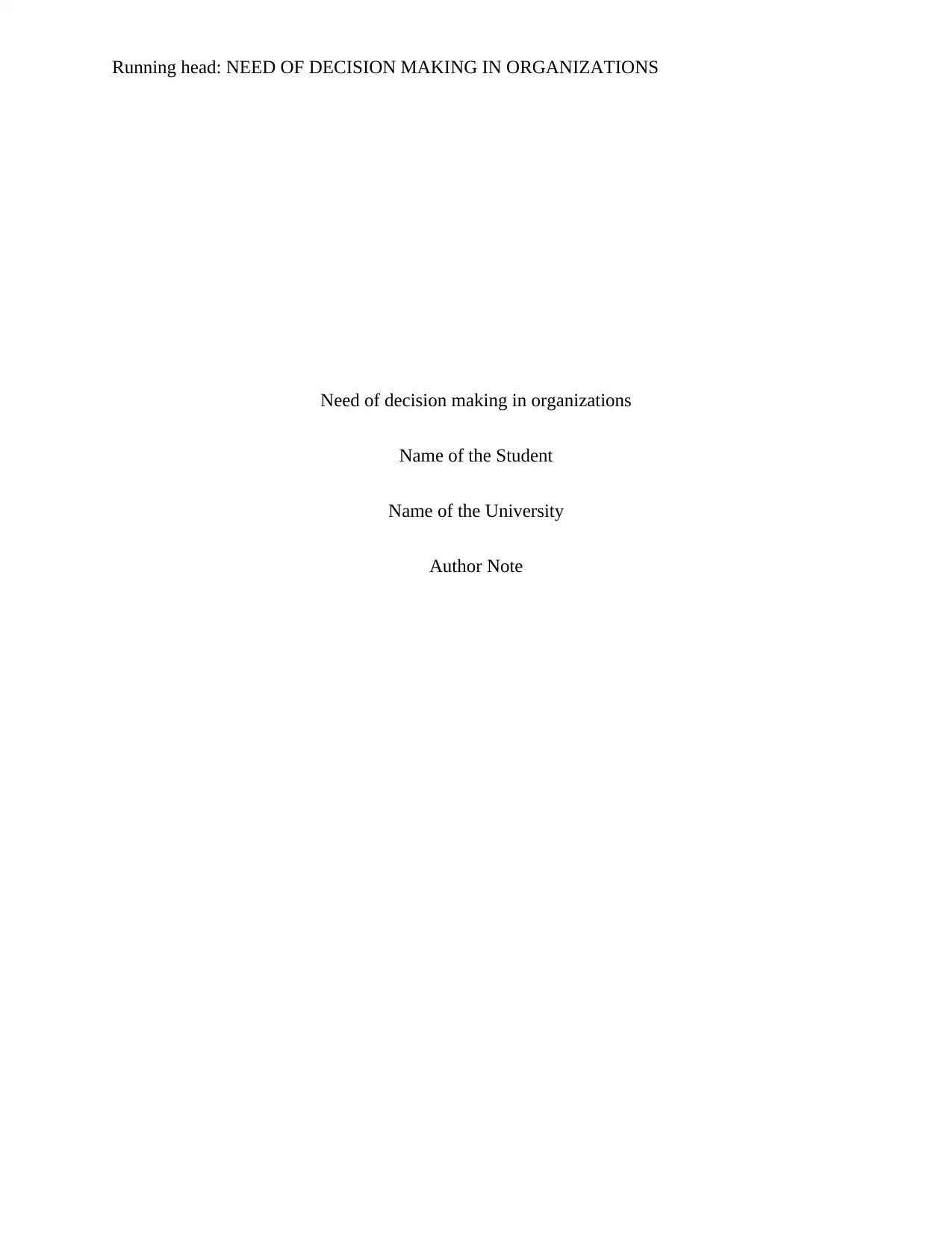
Running head: NEED OF DECISION MAKING IN ORGANIZATIONS
Need of decision making in organizations
Name of the Student
Name of the University
Author Note
Need of decision making in organizations
Name of the Student
Name of the University
Author Note
Secure Best Marks with AI Grader
Need help grading? Try our AI Grader for instant feedback on your assignments.
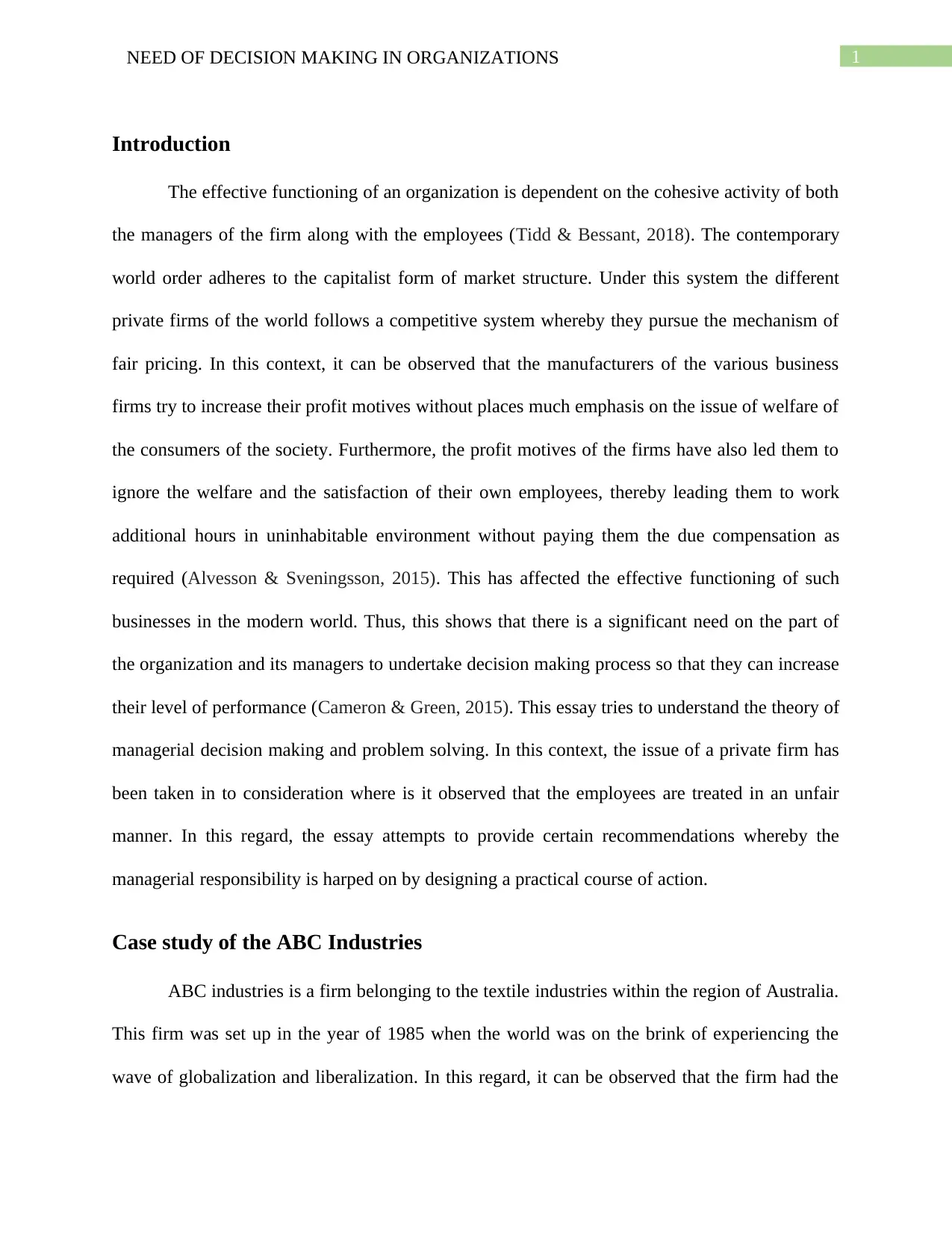
1NEED OF DECISION MAKING IN ORGANIZATIONS
Introduction
The effective functioning of an organization is dependent on the cohesive activity of both
the managers of the firm along with the employees (Tidd & Bessant, 2018). The contemporary
world order adheres to the capitalist form of market structure. Under this system the different
private firms of the world follows a competitive system whereby they pursue the mechanism of
fair pricing. In this context, it can be observed that the manufacturers of the various business
firms try to increase their profit motives without places much emphasis on the issue of welfare of
the consumers of the society. Furthermore, the profit motives of the firms have also led them to
ignore the welfare and the satisfaction of their own employees, thereby leading them to work
additional hours in uninhabitable environment without paying them the due compensation as
required (Alvesson & Sveningsson, 2015). This has affected the effective functioning of such
businesses in the modern world. Thus, this shows that there is a significant need on the part of
the organization and its managers to undertake decision making process so that they can increase
their level of performance (Cameron & Green, 2015). This essay tries to understand the theory of
managerial decision making and problem solving. In this context, the issue of a private firm has
been taken in to consideration where is it observed that the employees are treated in an unfair
manner. In this regard, the essay attempts to provide certain recommendations whereby the
managerial responsibility is harped on by designing a practical course of action.
Case study of the ABC Industries
ABC industries is a firm belonging to the textile industries within the region of Australia.
This firm was set up in the year of 1985 when the world was on the brink of experiencing the
wave of globalization and liberalization. In this regard, it can be observed that the firm had the
Introduction
The effective functioning of an organization is dependent on the cohesive activity of both
the managers of the firm along with the employees (Tidd & Bessant, 2018). The contemporary
world order adheres to the capitalist form of market structure. Under this system the different
private firms of the world follows a competitive system whereby they pursue the mechanism of
fair pricing. In this context, it can be observed that the manufacturers of the various business
firms try to increase their profit motives without places much emphasis on the issue of welfare of
the consumers of the society. Furthermore, the profit motives of the firms have also led them to
ignore the welfare and the satisfaction of their own employees, thereby leading them to work
additional hours in uninhabitable environment without paying them the due compensation as
required (Alvesson & Sveningsson, 2015). This has affected the effective functioning of such
businesses in the modern world. Thus, this shows that there is a significant need on the part of
the organization and its managers to undertake decision making process so that they can increase
their level of performance (Cameron & Green, 2015). This essay tries to understand the theory of
managerial decision making and problem solving. In this context, the issue of a private firm has
been taken in to consideration where is it observed that the employees are treated in an unfair
manner. In this regard, the essay attempts to provide certain recommendations whereby the
managerial responsibility is harped on by designing a practical course of action.
Case study of the ABC Industries
ABC industries is a firm belonging to the textile industries within the region of Australia.
This firm was set up in the year of 1985 when the world was on the brink of experiencing the
wave of globalization and liberalization. In this regard, it can be observed that the firm had the
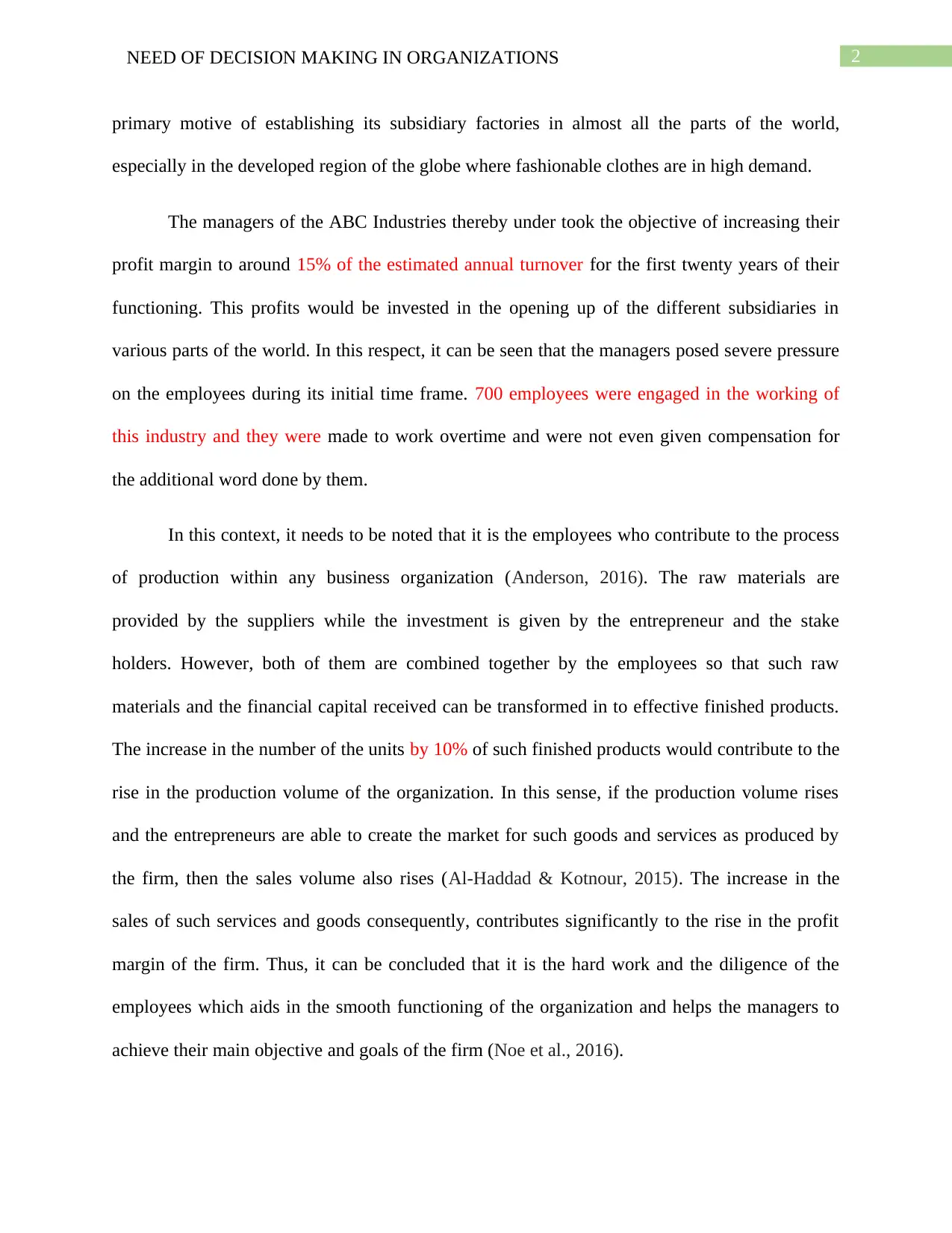
2NEED OF DECISION MAKING IN ORGANIZATIONS
primary motive of establishing its subsidiary factories in almost all the parts of the world,
especially in the developed region of the globe where fashionable clothes are in high demand.
The managers of the ABC Industries thereby under took the objective of increasing their
profit margin to around 15% of the estimated annual turnover for the first twenty years of their
functioning. This profits would be invested in the opening up of the different subsidiaries in
various parts of the world. In this respect, it can be seen that the managers posed severe pressure
on the employees during its initial time frame. 700 employees were engaged in the working of
this industry and they were made to work overtime and were not even given compensation for
the additional word done by them.
In this context, it needs to be noted that it is the employees who contribute to the process
of production within any business organization (Anderson, 2016). The raw materials are
provided by the suppliers while the investment is given by the entrepreneur and the stake
holders. However, both of them are combined together by the employees so that such raw
materials and the financial capital received can be transformed in to effective finished products.
The increase in the number of the units by 10% of such finished products would contribute to the
rise in the production volume of the organization. In this sense, if the production volume rises
and the entrepreneurs are able to create the market for such goods and services as produced by
the firm, then the sales volume also rises (Al-Haddad & Kotnour, 2015). The increase in the
sales of such services and goods consequently, contributes significantly to the rise in the profit
margin of the firm. Thus, it can be concluded that it is the hard work and the diligence of the
employees which aids in the smooth functioning of the organization and helps the managers to
achieve their main objective and goals of the firm (Noe et al., 2016).
primary motive of establishing its subsidiary factories in almost all the parts of the world,
especially in the developed region of the globe where fashionable clothes are in high demand.
The managers of the ABC Industries thereby under took the objective of increasing their
profit margin to around 15% of the estimated annual turnover for the first twenty years of their
functioning. This profits would be invested in the opening up of the different subsidiaries in
various parts of the world. In this respect, it can be seen that the managers posed severe pressure
on the employees during its initial time frame. 700 employees were engaged in the working of
this industry and they were made to work overtime and were not even given compensation for
the additional word done by them.
In this context, it needs to be noted that it is the employees who contribute to the process
of production within any business organization (Anderson, 2016). The raw materials are
provided by the suppliers while the investment is given by the entrepreneur and the stake
holders. However, both of them are combined together by the employees so that such raw
materials and the financial capital received can be transformed in to effective finished products.
The increase in the number of the units by 10% of such finished products would contribute to the
rise in the production volume of the organization. In this sense, if the production volume rises
and the entrepreneurs are able to create the market for such goods and services as produced by
the firm, then the sales volume also rises (Al-Haddad & Kotnour, 2015). The increase in the
sales of such services and goods consequently, contributes significantly to the rise in the profit
margin of the firm. Thus, it can be concluded that it is the hard work and the diligence of the
employees which aids in the smooth functioning of the organization and helps the managers to
achieve their main objective and goals of the firm (Noe et al., 2016).
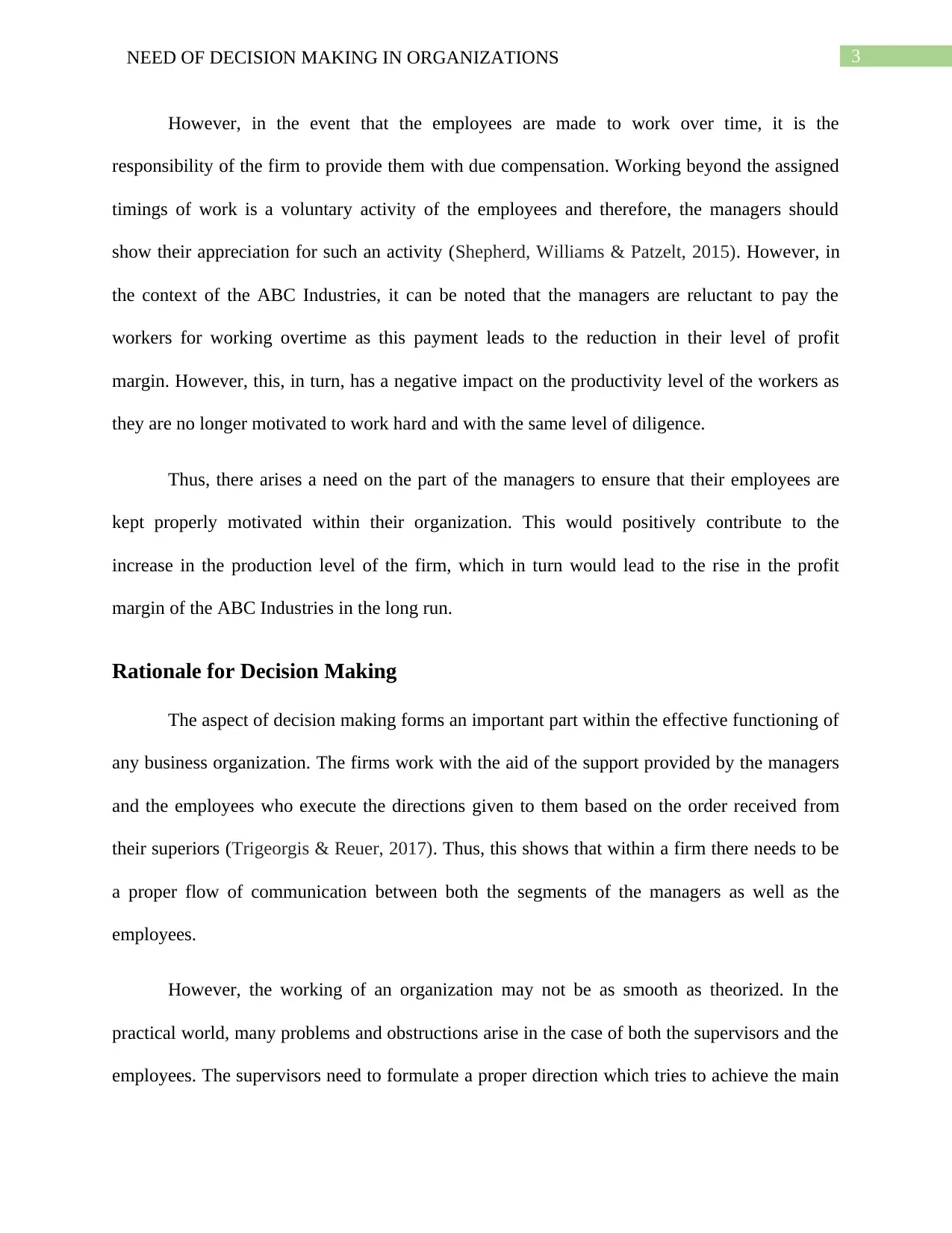
3NEED OF DECISION MAKING IN ORGANIZATIONS
However, in the event that the employees are made to work over time, it is the
responsibility of the firm to provide them with due compensation. Working beyond the assigned
timings of work is a voluntary activity of the employees and therefore, the managers should
show their appreciation for such an activity (Shepherd, Williams & Patzelt, 2015). However, in
the context of the ABC Industries, it can be noted that the managers are reluctant to pay the
workers for working overtime as this payment leads to the reduction in their level of profit
margin. However, this, in turn, has a negative impact on the productivity level of the workers as
they are no longer motivated to work hard and with the same level of diligence.
Thus, there arises a need on the part of the managers to ensure that their employees are
kept properly motivated within their organization. This would positively contribute to the
increase in the production level of the firm, which in turn would lead to the rise in the profit
margin of the ABC Industries in the long run.
Rationale for Decision Making
The aspect of decision making forms an important part within the effective functioning of
any business organization. The firms work with the aid of the support provided by the managers
and the employees who execute the directions given to them based on the order received from
their superiors (Trigeorgis & Reuer, 2017). Thus, this shows that within a firm there needs to be
a proper flow of communication between both the segments of the managers as well as the
employees.
However, the working of an organization may not be as smooth as theorized. In the
practical world, many problems and obstructions arise in the case of both the supervisors and the
employees. The supervisors need to formulate a proper direction which tries to achieve the main
However, in the event that the employees are made to work over time, it is the
responsibility of the firm to provide them with due compensation. Working beyond the assigned
timings of work is a voluntary activity of the employees and therefore, the managers should
show their appreciation for such an activity (Shepherd, Williams & Patzelt, 2015). However, in
the context of the ABC Industries, it can be noted that the managers are reluctant to pay the
workers for working overtime as this payment leads to the reduction in their level of profit
margin. However, this, in turn, has a negative impact on the productivity level of the workers as
they are no longer motivated to work hard and with the same level of diligence.
Thus, there arises a need on the part of the managers to ensure that their employees are
kept properly motivated within their organization. This would positively contribute to the
increase in the production level of the firm, which in turn would lead to the rise in the profit
margin of the ABC Industries in the long run.
Rationale for Decision Making
The aspect of decision making forms an important part within the effective functioning of
any business organization. The firms work with the aid of the support provided by the managers
and the employees who execute the directions given to them based on the order received from
their superiors (Trigeorgis & Reuer, 2017). Thus, this shows that within a firm there needs to be
a proper flow of communication between both the segments of the managers as well as the
employees.
However, the working of an organization may not be as smooth as theorized. In the
practical world, many problems and obstructions arise in the case of both the supervisors and the
employees. The supervisors need to formulate a proper direction which tries to achieve the main
Secure Best Marks with AI Grader
Need help grading? Try our AI Grader for instant feedback on your assignments.
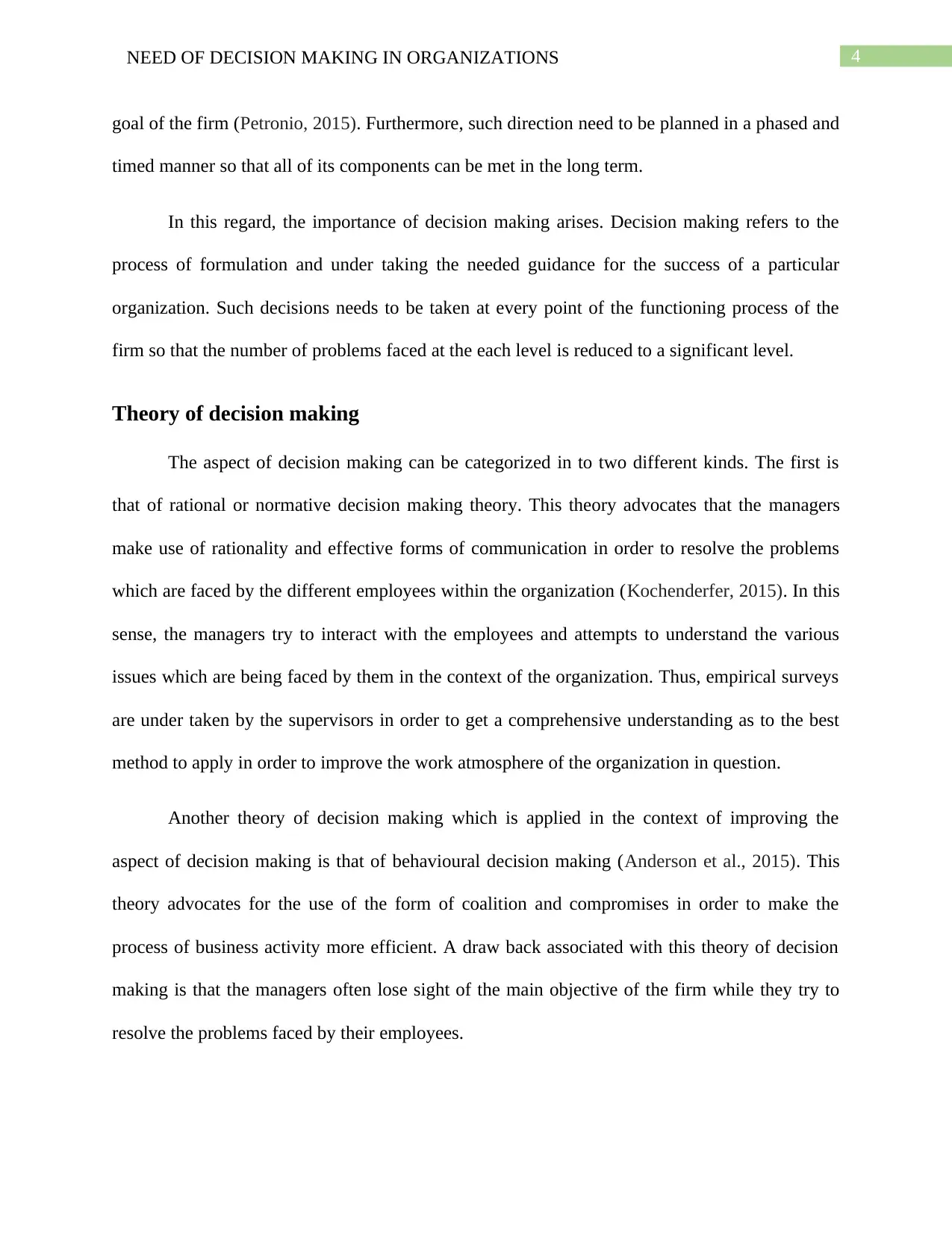
4NEED OF DECISION MAKING IN ORGANIZATIONS
goal of the firm (Petronio, 2015). Furthermore, such direction need to be planned in a phased and
timed manner so that all of its components can be met in the long term.
In this regard, the importance of decision making arises. Decision making refers to the
process of formulation and under taking the needed guidance for the success of a particular
organization. Such decisions needs to be taken at every point of the functioning process of the
firm so that the number of problems faced at the each level is reduced to a significant level.
Theory of decision making
The aspect of decision making can be categorized in to two different kinds. The first is
that of rational or normative decision making theory. This theory advocates that the managers
make use of rationality and effective forms of communication in order to resolve the problems
which are faced by the different employees within the organization (Kochenderfer, 2015). In this
sense, the managers try to interact with the employees and attempts to understand the various
issues which are being faced by them in the context of the organization. Thus, empirical surveys
are under taken by the supervisors in order to get a comprehensive understanding as to the best
method to apply in order to improve the work atmosphere of the organization in question.
Another theory of decision making which is applied in the context of improving the
aspect of decision making is that of behavioural decision making (Anderson et al., 2015). This
theory advocates for the use of the form of coalition and compromises in order to make the
process of business activity more efficient. A draw back associated with this theory of decision
making is that the managers often lose sight of the main objective of the firm while they try to
resolve the problems faced by their employees.
goal of the firm (Petronio, 2015). Furthermore, such direction need to be planned in a phased and
timed manner so that all of its components can be met in the long term.
In this regard, the importance of decision making arises. Decision making refers to the
process of formulation and under taking the needed guidance for the success of a particular
organization. Such decisions needs to be taken at every point of the functioning process of the
firm so that the number of problems faced at the each level is reduced to a significant level.
Theory of decision making
The aspect of decision making can be categorized in to two different kinds. The first is
that of rational or normative decision making theory. This theory advocates that the managers
make use of rationality and effective forms of communication in order to resolve the problems
which are faced by the different employees within the organization (Kochenderfer, 2015). In this
sense, the managers try to interact with the employees and attempts to understand the various
issues which are being faced by them in the context of the organization. Thus, empirical surveys
are under taken by the supervisors in order to get a comprehensive understanding as to the best
method to apply in order to improve the work atmosphere of the organization in question.
Another theory of decision making which is applied in the context of improving the
aspect of decision making is that of behavioural decision making (Anderson et al., 2015). This
theory advocates for the use of the form of coalition and compromises in order to make the
process of business activity more efficient. A draw back associated with this theory of decision
making is that the managers often lose sight of the main objective of the firm while they try to
resolve the problems faced by their employees.
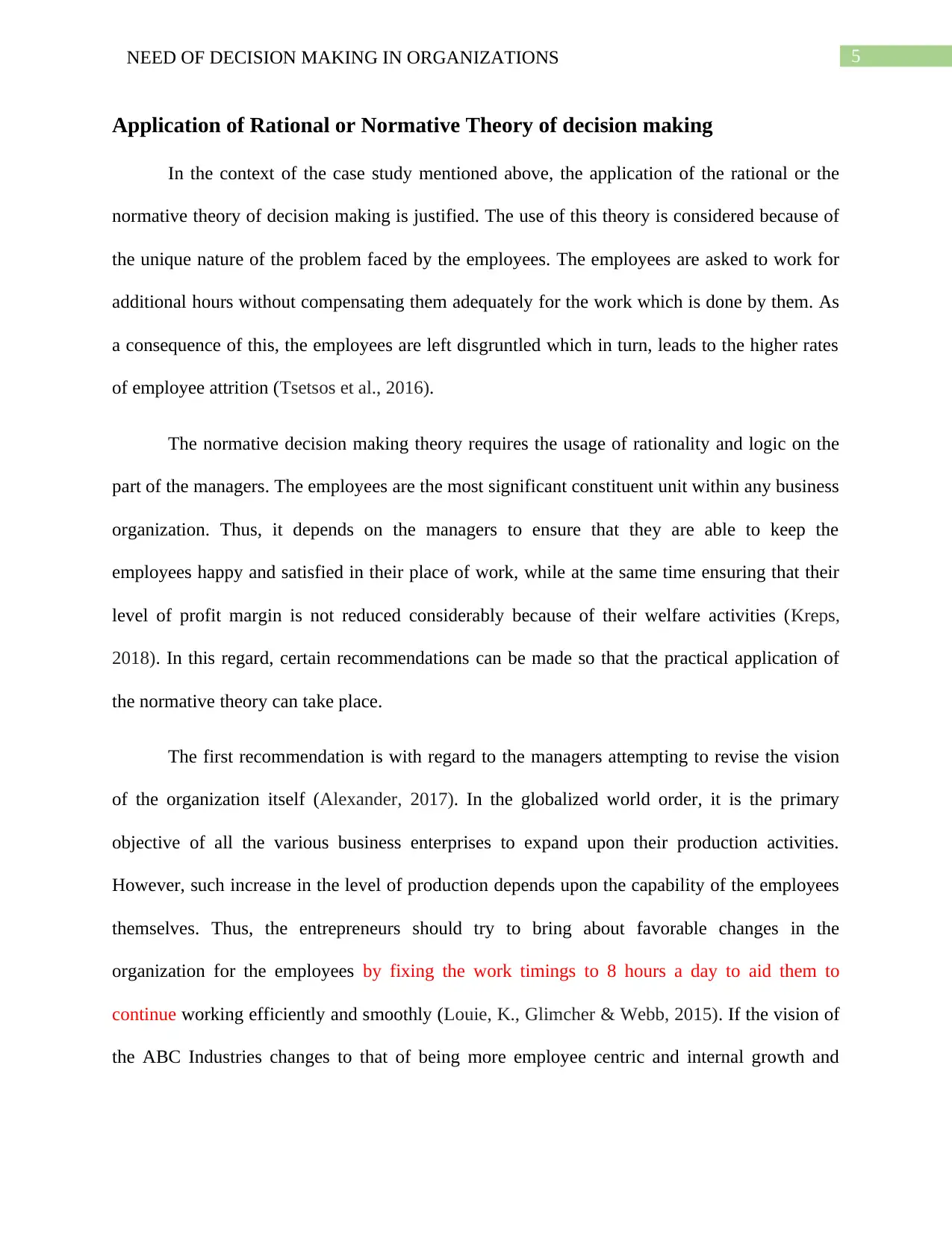
5NEED OF DECISION MAKING IN ORGANIZATIONS
Application of Rational or Normative Theory of decision making
In the context of the case study mentioned above, the application of the rational or the
normative theory of decision making is justified. The use of this theory is considered because of
the unique nature of the problem faced by the employees. The employees are asked to work for
additional hours without compensating them adequately for the work which is done by them. As
a consequence of this, the employees are left disgruntled which in turn, leads to the higher rates
of employee attrition (Tsetsos et al., 2016).
The normative decision making theory requires the usage of rationality and logic on the
part of the managers. The employees are the most significant constituent unit within any business
organization. Thus, it depends on the managers to ensure that they are able to keep the
employees happy and satisfied in their place of work, while at the same time ensuring that their
level of profit margin is not reduced considerably because of their welfare activities (Kreps,
2018). In this regard, certain recommendations can be made so that the practical application of
the normative theory can take place.
The first recommendation is with regard to the managers attempting to revise the vision
of the organization itself (Alexander, 2017). In the globalized world order, it is the primary
objective of all the various business enterprises to expand upon their production activities.
However, such increase in the level of production depends upon the capability of the employees
themselves. Thus, the entrepreneurs should try to bring about favorable changes in the
organization for the employees by fixing the work timings to 8 hours a day to aid them to
continue working efficiently and smoothly (Louie, K., Glimcher & Webb, 2015). If the vision of
the ABC Industries changes to that of being more employee centric and internal growth and
Application of Rational or Normative Theory of decision making
In the context of the case study mentioned above, the application of the rational or the
normative theory of decision making is justified. The use of this theory is considered because of
the unique nature of the problem faced by the employees. The employees are asked to work for
additional hours without compensating them adequately for the work which is done by them. As
a consequence of this, the employees are left disgruntled which in turn, leads to the higher rates
of employee attrition (Tsetsos et al., 2016).
The normative decision making theory requires the usage of rationality and logic on the
part of the managers. The employees are the most significant constituent unit within any business
organization. Thus, it depends on the managers to ensure that they are able to keep the
employees happy and satisfied in their place of work, while at the same time ensuring that their
level of profit margin is not reduced considerably because of their welfare activities (Kreps,
2018). In this regard, certain recommendations can be made so that the practical application of
the normative theory can take place.
The first recommendation is with regard to the managers attempting to revise the vision
of the organization itself (Alexander, 2017). In the globalized world order, it is the primary
objective of all the various business enterprises to expand upon their production activities.
However, such increase in the level of production depends upon the capability of the employees
themselves. Thus, the entrepreneurs should try to bring about favorable changes in the
organization for the employees by fixing the work timings to 8 hours a day to aid them to
continue working efficiently and smoothly (Louie, K., Glimcher & Webb, 2015). If the vision of
the ABC Industries changes to that of being more employee centric and internal growth and
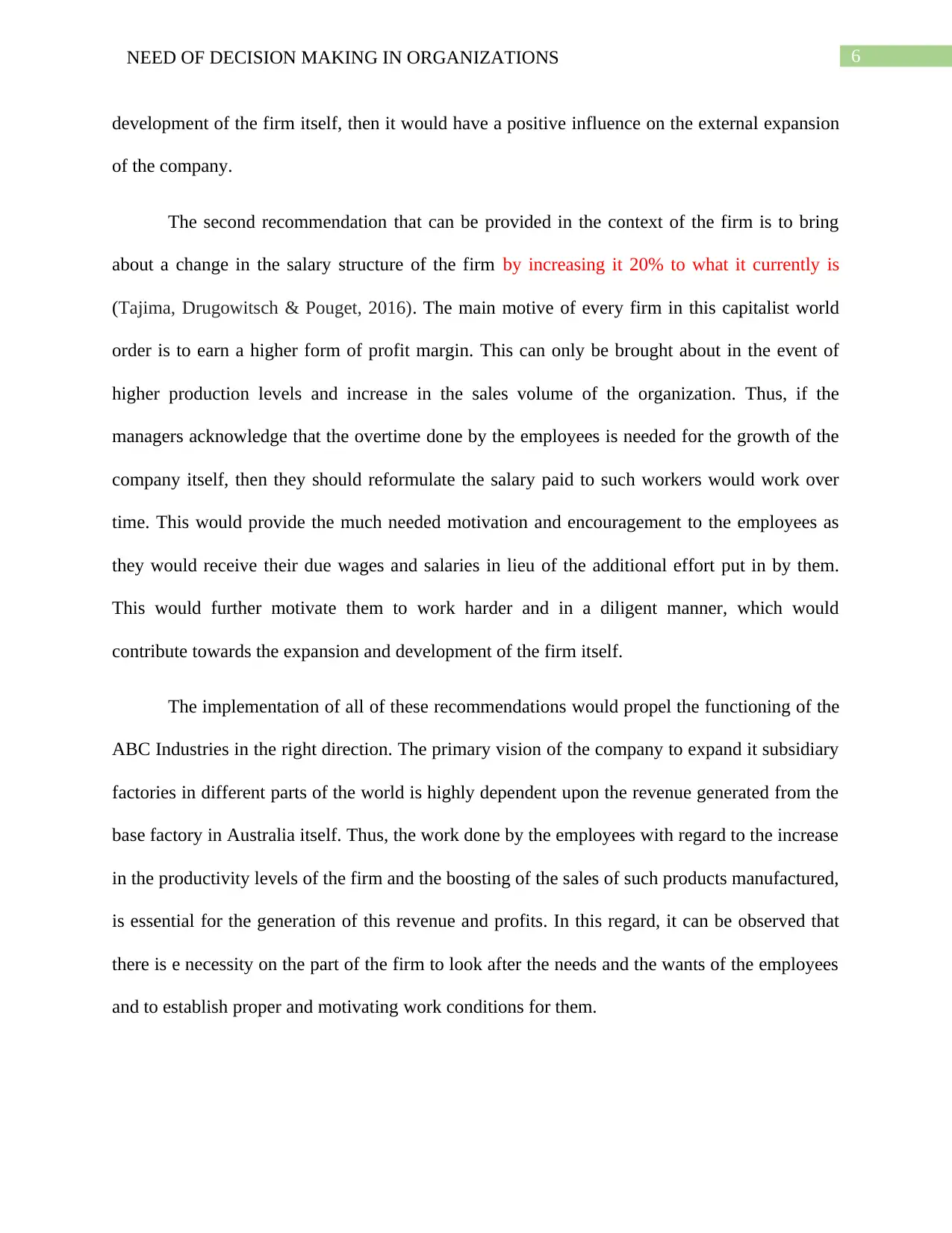
6NEED OF DECISION MAKING IN ORGANIZATIONS
development of the firm itself, then it would have a positive influence on the external expansion
of the company.
The second recommendation that can be provided in the context of the firm is to bring
about a change in the salary structure of the firm by increasing it 20% to what it currently is
(Tajima, Drugowitsch & Pouget, 2016). The main motive of every firm in this capitalist world
order is to earn a higher form of profit margin. This can only be brought about in the event of
higher production levels and increase in the sales volume of the organization. Thus, if the
managers acknowledge that the overtime done by the employees is needed for the growth of the
company itself, then they should reformulate the salary paid to such workers would work over
time. This would provide the much needed motivation and encouragement to the employees as
they would receive their due wages and salaries in lieu of the additional effort put in by them.
This would further motivate them to work harder and in a diligent manner, which would
contribute towards the expansion and development of the firm itself.
The implementation of all of these recommendations would propel the functioning of the
ABC Industries in the right direction. The primary vision of the company to expand it subsidiary
factories in different parts of the world is highly dependent upon the revenue generated from the
base factory in Australia itself. Thus, the work done by the employees with regard to the increase
in the productivity levels of the firm and the boosting of the sales of such products manufactured,
is essential for the generation of this revenue and profits. In this regard, it can be observed that
there is e necessity on the part of the firm to look after the needs and the wants of the employees
and to establish proper and motivating work conditions for them.
development of the firm itself, then it would have a positive influence on the external expansion
of the company.
The second recommendation that can be provided in the context of the firm is to bring
about a change in the salary structure of the firm by increasing it 20% to what it currently is
(Tajima, Drugowitsch & Pouget, 2016). The main motive of every firm in this capitalist world
order is to earn a higher form of profit margin. This can only be brought about in the event of
higher production levels and increase in the sales volume of the organization. Thus, if the
managers acknowledge that the overtime done by the employees is needed for the growth of the
company itself, then they should reformulate the salary paid to such workers would work over
time. This would provide the much needed motivation and encouragement to the employees as
they would receive their due wages and salaries in lieu of the additional effort put in by them.
This would further motivate them to work harder and in a diligent manner, which would
contribute towards the expansion and development of the firm itself.
The implementation of all of these recommendations would propel the functioning of the
ABC Industries in the right direction. The primary vision of the company to expand it subsidiary
factories in different parts of the world is highly dependent upon the revenue generated from the
base factory in Australia itself. Thus, the work done by the employees with regard to the increase
in the productivity levels of the firm and the boosting of the sales of such products manufactured,
is essential for the generation of this revenue and profits. In this regard, it can be observed that
there is e necessity on the part of the firm to look after the needs and the wants of the employees
and to establish proper and motivating work conditions for them.
Paraphrase This Document
Need a fresh take? Get an instant paraphrase of this document with our AI Paraphraser
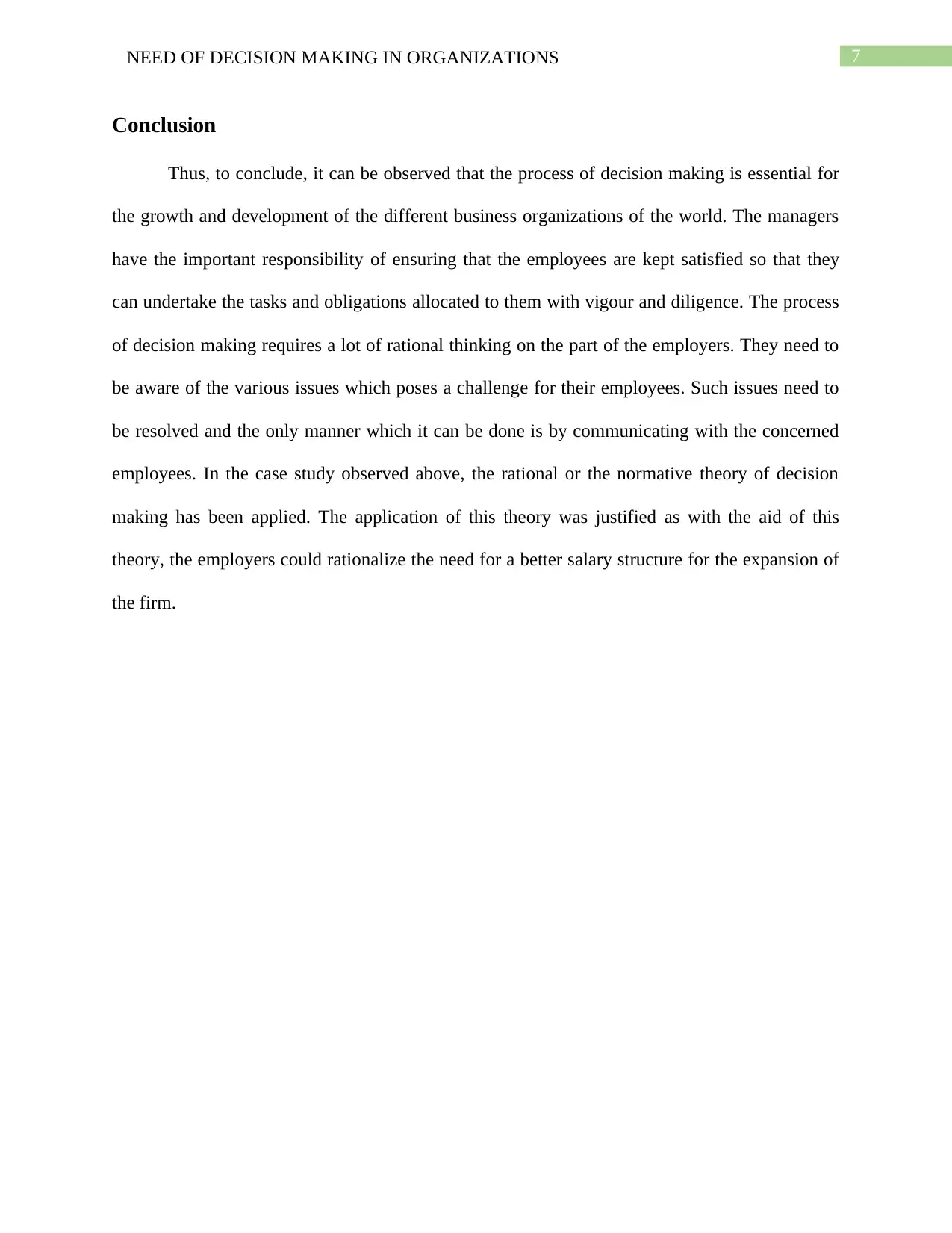
7NEED OF DECISION MAKING IN ORGANIZATIONS
Conclusion
Thus, to conclude, it can be observed that the process of decision making is essential for
the growth and development of the different business organizations of the world. The managers
have the important responsibility of ensuring that the employees are kept satisfied so that they
can undertake the tasks and obligations allocated to them with vigour and diligence. The process
of decision making requires a lot of rational thinking on the part of the employers. They need to
be aware of the various issues which poses a challenge for their employees. Such issues need to
be resolved and the only manner which it can be done is by communicating with the concerned
employees. In the case study observed above, the rational or the normative theory of decision
making has been applied. The application of this theory was justified as with the aid of this
theory, the employers could rationalize the need for a better salary structure for the expansion of
the firm.
Conclusion
Thus, to conclude, it can be observed that the process of decision making is essential for
the growth and development of the different business organizations of the world. The managers
have the important responsibility of ensuring that the employees are kept satisfied so that they
can undertake the tasks and obligations allocated to them with vigour and diligence. The process
of decision making requires a lot of rational thinking on the part of the employers. They need to
be aware of the various issues which poses a challenge for their employees. Such issues need to
be resolved and the only manner which it can be done is by communicating with the concerned
employees. In the case study observed above, the rational or the normative theory of decision
making has been applied. The application of this theory was justified as with the aid of this
theory, the employers could rationalize the need for a better salary structure for the expansion of
the firm.
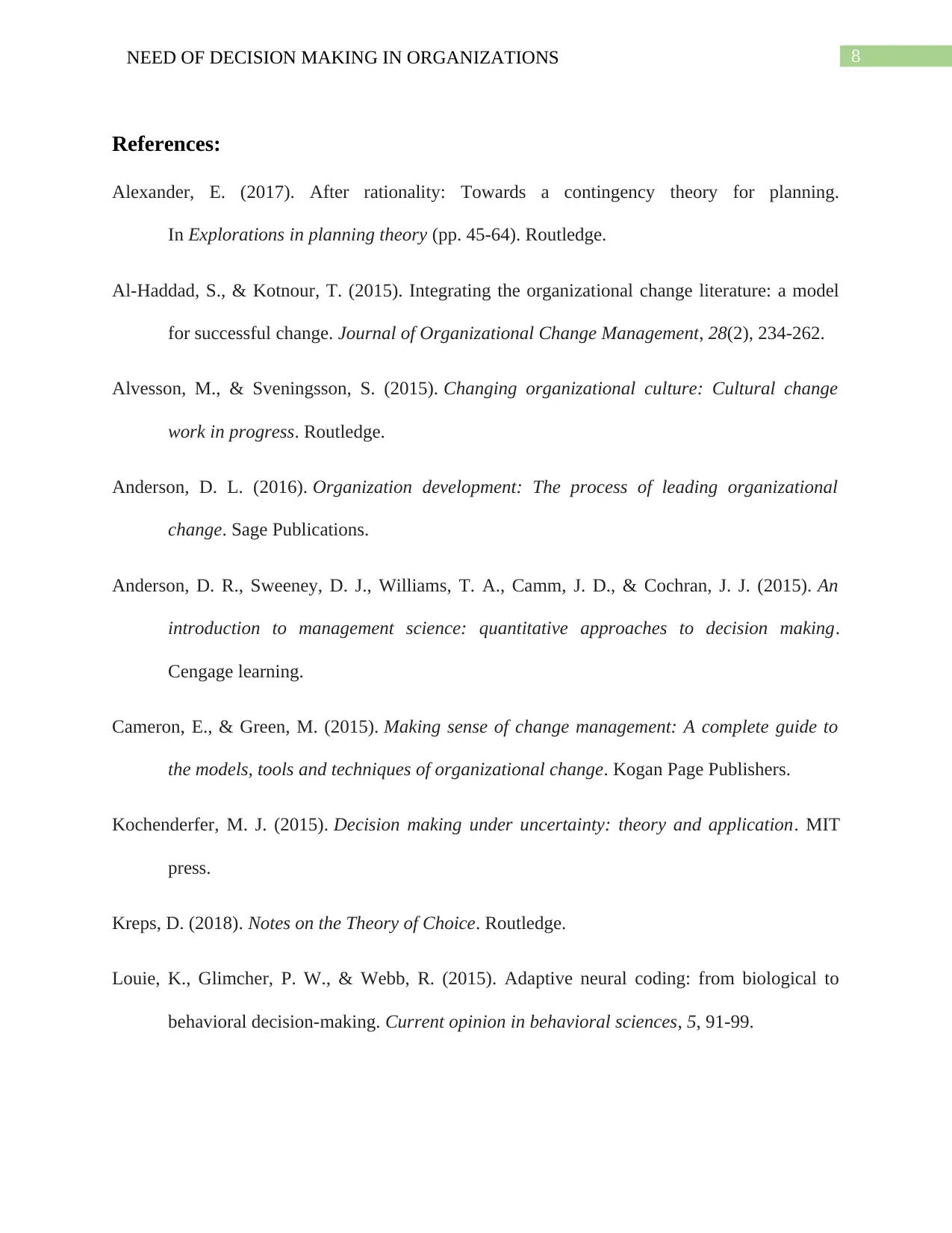
8NEED OF DECISION MAKING IN ORGANIZATIONS
References:
Alexander, E. (2017). After rationality: Towards a contingency theory for planning.
In Explorations in planning theory (pp. 45-64). Routledge.
Al-Haddad, S., & Kotnour, T. (2015). Integrating the organizational change literature: a model
for successful change. Journal of Organizational Change Management, 28(2), 234-262.
Alvesson, M., & Sveningsson, S. (2015). Changing organizational culture: Cultural change
work in progress. Routledge.
Anderson, D. L. (2016). Organization development: The process of leading organizational
change. Sage Publications.
Anderson, D. R., Sweeney, D. J., Williams, T. A., Camm, J. D., & Cochran, J. J. (2015). An
introduction to management science: quantitative approaches to decision making.
Cengage learning.
Cameron, E., & Green, M. (2015). Making sense of change management: A complete guide to
the models, tools and techniques of organizational change. Kogan Page Publishers.
Kochenderfer, M. J. (2015). Decision making under uncertainty: theory and application. MIT
press.
Kreps, D. (2018). Notes on the Theory of Choice. Routledge.
Louie, K., Glimcher, P. W., & Webb, R. (2015). Adaptive neural coding: from biological to
behavioral decision-making. Current opinion in behavioral sciences, 5, 91-99.
References:
Alexander, E. (2017). After rationality: Towards a contingency theory for planning.
In Explorations in planning theory (pp. 45-64). Routledge.
Al-Haddad, S., & Kotnour, T. (2015). Integrating the organizational change literature: a model
for successful change. Journal of Organizational Change Management, 28(2), 234-262.
Alvesson, M., & Sveningsson, S. (2015). Changing organizational culture: Cultural change
work in progress. Routledge.
Anderson, D. L. (2016). Organization development: The process of leading organizational
change. Sage Publications.
Anderson, D. R., Sweeney, D. J., Williams, T. A., Camm, J. D., & Cochran, J. J. (2015). An
introduction to management science: quantitative approaches to decision making.
Cengage learning.
Cameron, E., & Green, M. (2015). Making sense of change management: A complete guide to
the models, tools and techniques of organizational change. Kogan Page Publishers.
Kochenderfer, M. J. (2015). Decision making under uncertainty: theory and application. MIT
press.
Kreps, D. (2018). Notes on the Theory of Choice. Routledge.
Louie, K., Glimcher, P. W., & Webb, R. (2015). Adaptive neural coding: from biological to
behavioral decision-making. Current opinion in behavioral sciences, 5, 91-99.
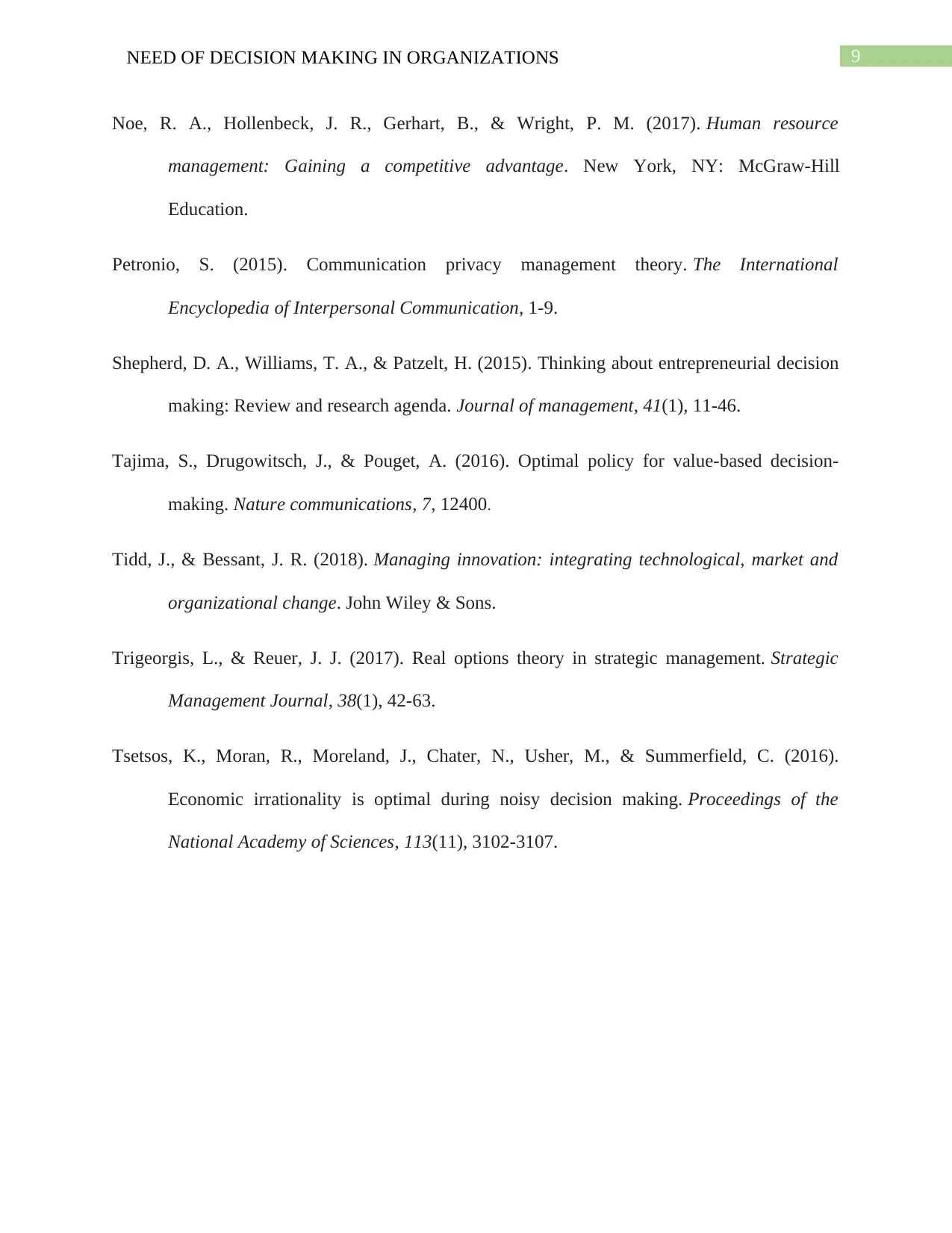
9NEED OF DECISION MAKING IN ORGANIZATIONS
Noe, R. A., Hollenbeck, J. R., Gerhart, B., & Wright, P. M. (2017). Human resource
management: Gaining a competitive advantage. New York, NY: McGraw-Hill
Education.
Petronio, S. (2015). Communication privacy management theory. The International
Encyclopedia of Interpersonal Communication, 1-9.
Shepherd, D. A., Williams, T. A., & Patzelt, H. (2015). Thinking about entrepreneurial decision
making: Review and research agenda. Journal of management, 41(1), 11-46.
Tajima, S., Drugowitsch, J., & Pouget, A. (2016). Optimal policy for value-based decision-
making. Nature communications, 7, 12400.
Tidd, J., & Bessant, J. R. (2018). Managing innovation: integrating technological, market and
organizational change. John Wiley & Sons.
Trigeorgis, L., & Reuer, J. J. (2017). Real options theory in strategic management. Strategic
Management Journal, 38(1), 42-63.
Tsetsos, K., Moran, R., Moreland, J., Chater, N., Usher, M., & Summerfield, C. (2016).
Economic irrationality is optimal during noisy decision making. Proceedings of the
National Academy of Sciences, 113(11), 3102-3107.
Noe, R. A., Hollenbeck, J. R., Gerhart, B., & Wright, P. M. (2017). Human resource
management: Gaining a competitive advantage. New York, NY: McGraw-Hill
Education.
Petronio, S. (2015). Communication privacy management theory. The International
Encyclopedia of Interpersonal Communication, 1-9.
Shepherd, D. A., Williams, T. A., & Patzelt, H. (2015). Thinking about entrepreneurial decision
making: Review and research agenda. Journal of management, 41(1), 11-46.
Tajima, S., Drugowitsch, J., & Pouget, A. (2016). Optimal policy for value-based decision-
making. Nature communications, 7, 12400.
Tidd, J., & Bessant, J. R. (2018). Managing innovation: integrating technological, market and
organizational change. John Wiley & Sons.
Trigeorgis, L., & Reuer, J. J. (2017). Real options theory in strategic management. Strategic
Management Journal, 38(1), 42-63.
Tsetsos, K., Moran, R., Moreland, J., Chater, N., Usher, M., & Summerfield, C. (2016).
Economic irrationality is optimal during noisy decision making. Proceedings of the
National Academy of Sciences, 113(11), 3102-3107.
1 out of 10
Related Documents
Your All-in-One AI-Powered Toolkit for Academic Success.
+13062052269
info@desklib.com
Available 24*7 on WhatsApp / Email
![[object Object]](/_next/static/media/star-bottom.7253800d.svg)
Unlock your academic potential
© 2024 | Zucol Services PVT LTD | All rights reserved.





